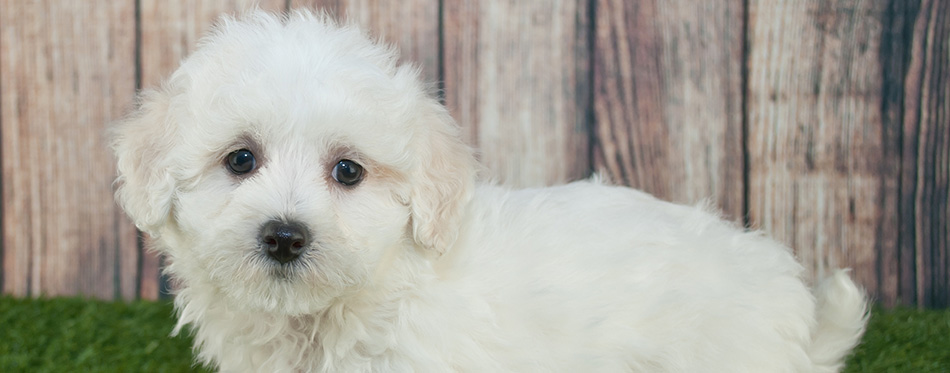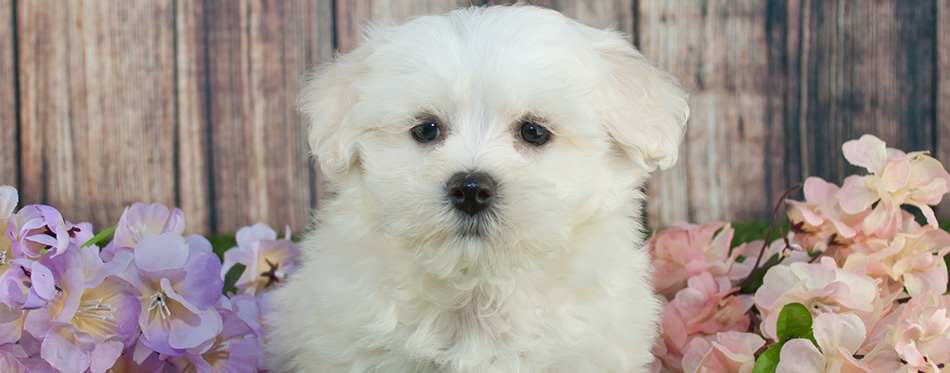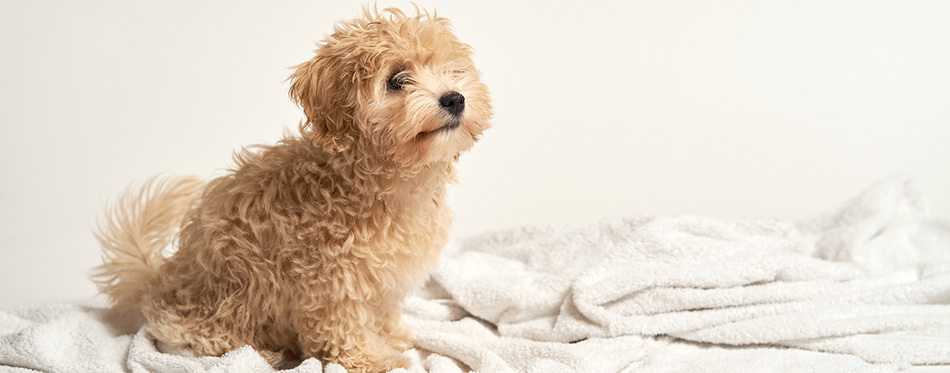The Maltipoo is a mixed breed of dog that is known for its affectionate and fun-loving nature. It has the intelligence of a Poodle and the friendliness of the Maltese. The Maltipoo also has the low-shedding potential of both its parents. While major kennel organizations have yet to recognize it as a breed, the Maltipoo has clearly won the hearts of many. Here is everything you have to know about this adorable family companion.
History of the Maltipoo
Many people believe that designer breeds are a new phenomenon. These dogs reached mainstream consciousness when celebrities and socialites began bringing their mixed breed pets along in their social functions. The earliest of these “social appearances” was some time in the late 1990s. This led to the conclusion that popular mixed breeds, like the Maltipoo, were created sometime in the early 1990s or the middle of the 1980s.
What many may not realize is that there are many purebred dogs today that started out as “crossbreeds”. For instance, the Golden Retriever is the result of crossbreeding a Tweed Water Spaniel and a yellow retriever. To strengthen the desired qualities in the Golden Retriever, the resulting litter was again crossbred with other dog breeds. These included the St. John’s Water Dog, Black retrievers, the Irish Setter, and the Bloodhound. This was in the 19th century, more than a hundred years before the so-called designer breeds.
While the Maltipoo is a “new” creation, the process of crossbreeding is not. There is also the chance that the Maltese Poodle Mix may have already been around since the middle of the 20th century. People did not pay attention to it. It was only when socialites and celebrities started showing these dogs off that people began to take notice.
Regardless of the actual origin of the Maltipoo, this is a crossbreed that involves the Maltese and the Miniature or Toy Poodle. It is important that the Poodle parent be either a Toy or a Miniature type. Using a Standard Poodle will be physically impossible to impregnate the dog using natural means. It is still possible, though. One can use artificial insemination to get the sperm cells from a Maltese male to a Standard Poodle female. Given the wide variance in size, most Maltipoo breeders opt for the smaller types of Poodle when crossbreeding it with a Maltese.
To better understand what a Maltipoo is like, it is best to look at its individual foundation parent breeds.

Maltese
Maltese owners love the dog’s sweet demeanor. Its devotion, affection, and loyalty to its family is well-known. After all, this is a breed that Mediterranean royalty favored as a companion dog. Despite the tendency of its owners to pamper the dog, the Maltese is never arrogant. It has a playful and biddable nature to go with its innate intelligence. It relies on these characteristics to bring joy and happiness to its owners and their children.
While the Maltese may have started as a companion dog, it is now one of the most admired therapy dogs in the world. Its sweet temperament and caring behavior make the Maltese an invaluable companion among persons needing some therapy. Asthmatics and hypersensitive persons will not have any issues with a Maltese because it sheds very little.
No one can be certain as to when the Maltese first came into being. Greek amphoras that archeologists dug in Vulci, Italy depicted Maltese-looking dogs. If such images are indeed the ancestors of the Maltese, then this breed has been accompanying man since circa-500 BC.
While the Maltese has been around for more than 25 centuries, it is not immune to canine diseases. This dog is still vulnerable to progressive retinal atrophy, hypoglycemia, collapsed trachea, and luxating patellas. Some of them can also present with reverse sneezing and liver shunt.
The Maltese can only have a white coat. This is a characteristic that is very unique to the breed. A male Maltese can weigh about 3 to 8 lbs while females are 2 to 7 lbs in weight. They are a small breed, not taller than 10 inches for males and 9 inches for females.
Take a look at our review of Dog Food for Maltese for more options.
Poodle
Derived from the German Pudel, the Poodle is one of the world’s most lovable pet dogs. It is very witty and has a clownish behavior that people associate with circus dogs. The media always depicts the Poodle as a French dog. This is not accurate, however. Major kennel organizations recognize the Poodle as having a German origin. Germany, for its part, gave France the right to call the Poodle a French original. This is in an effort to avoid possible disputes in the FCI. Hence, records will show that the Poodle came from the Barbet, a French water dog.
Both the French Barbet and the German Pudel are excellent hunters. The Barbet is known for its swimming abilities, a trait that the Poodle also has. The Pudel, on the other hand, is well-known for its hunting instincts. It is an excellent tracker and retriever. Either of these breeds can provide the genetic makeup of the Poodle. It is a reliable hunter and a very prolific swimmer.
Like the Maltese, no one can pinpoint the exact location of the origins of the Poodle or in what year it first came about. Records do show that Poodle-like dogs have already existed as early as the 15th century. These dogs come in three types. The Standard is the oldest of the three, while the Toy variety is the ‘youngest’.
Despite their size differences, Poodles are excellent hunters. They show certain hunting specialties, however. For instance, the Standard Poodle is great in game hunting and fowl retrieving. The Miniature Poodle is excellent in detecting truffles. Their small feet allowed them to look for these expensive delicacies without damaging them. The Toy Poodle, on the other hand, is more popular as a companion dog.
According to the AKC, the Miniature Poodle should be 10 to 15 inches tall. The Toy Poodle should not be taller than 10 inches. They come in different colors and patterns like brindle and phantom. The most common Poodle colors are white, black, gray, brown, beige, cream, and red.
Poodles have an average lifespan of 14.5 years. They are known for developing gastric dilatation volvulus, Addison’s disease, kidney disease, epilepsy, and hip dysplasia. Others may have tracheal collapse and cancer.
Quick Facts About the Maltipoo
There is no doubt that the Maltipoo is an adorable designer breed. We may not know the exact origins of the Maltipoo but we do know the following facts.
- It is a Small Designer Breed
Maltipoos can reach a height of 8 to 14 inches, often depending on the size of their parents. They can also weigh as light as 5 lbs or as heavy as 20 lbs. One has to remember that the Maltipoo is a companion dog.
The variance in the size and weight of the Maltipoo is dependent on the type of Poodle used in the crossbreeding. If the breeder used a Miniature Poodle, then the Maltipoo can be as tall as 14 inches and as heavy as 20 lbs. If it’s a Toy Poodle that’s used in the crossbreeding process, then you will get a Maltipoo that’s on the smaller side of things.
As mentioned, breeders do not use Standard Poodles in the creation of a Maltipoo. This will result in a larger designer dog. There are also issues in mating. The only way one can create a Maltipoo from a Standard Poodle is by inseminating a female Poodle. This is the only way one can expect to create a Maltese Standard Poodle mix.
- Coat Colors
If you mate a pure white Poodle with a Maltese, then you can expect the Maltipoo to be all white, too. Maltese dogs only come in white. Poodles, on the other hand, will come in different colors. Since this is a mating of two different breeds, the litter will show at least 50 percent of the trait of either parent. Maltipoos, in general, can come in various colors. They can be white, cream, brown, silver, blue, and apricot. Some can also have a combination of these colors.
- It Can Bark a Lot
The Maltipoo is not a quiet designer breed. It will bark when it requires the attention of its human family. It also barks when it senses something off. It is not a guard dog, however. This barking behavior is innate in the breed. However, you can always temper it with early training.
- Prone to Separation Anxiety
Separation anxiety is a very common behavior in Maltipoos. This is inherent in their strong desire to be with their human companions. If they do not see their favorite person for a long time, Maltipoos can grow depressed. Some can manifest destructive behaviors, too.
- Celebrities Love Them
Tinseltown has a name for Maltipoos: the little Teddy Bears. That is why it is not surprising why many celebrities have Maltipoos as pets. These include Rihanna’s Oliver, Miley Cyrus’ Sophie, Michelle Kwan’s Ginseng, Ashley Tisdale’s Maui and Blondie, and Blake Lively’s Penny. Madison Ziegler also has a Maltipoo named Maliboo.

Things You Should Know
You will not be alone in wanting to bring a Maltipoo home. There are thousands of other people who would love to bring home a Maltese Poodle Mix. Before you do, it is best that you brush up on your knowledge about a few more things about the Maltipoo.
Health
The Maltipoo can live for as long as 16 years. Some may only reach 14. Regardless, this is still a lot longer than the lifespan of large and giant breeds of dogs. This does not mean the Maltipoo will no longer suffer diseases.
Progressive retinal atrophy is quite common in this designer breed. It can lead to blindness if the condition is not detected and treated early. Some Maltipoos are also prone to Legg-Calve-Perthes disease. This is a condition that is not exclusive to the Maltipoo. Almost any other toy breed of dog has the disease. This can produce limping and the shrinking of the leg muscles.
Epilepsy is also quite common. Many cases of canine epilepsy are hereditary. It would be best to check with the breeder about the health history of the Maltipoo’s parents. If not, then a comprehensive DNA testing should help reveal if the Maltipoo has the genetic marker for the disease. For more options, check out our detailed review of the best DNA tests for dogs.
Other health problems that Maltipoo owners may have to know about include patellar luxation, White Shaker Syndrome, portosystemic shunt, hypoglycemia, heart disease, and cryptorchidism.
Training
Do not make the mistake of not training a Maltipoo. Many owners of toy dogs do not train their pets because of the belief that there is no need. An untrained Maltipoo can exhibit the classic symptoms of Small Dog Syndrome. You can think of this as the canine equivalent of the Napoleon Complex. The dog can be very yappy and can exert its will over the household.
Training should commence at the soonest possible time. Toilet training is important, as well as the training of basic obedience commands. These will help address potential behavioral problems in Maltipoos like jumping, excessive barking, and separation anxiety.
Exercise
All pet dogs need to exercise. Even so-called lap dogs need to move to prevent the atrophy of their muscles. Exercise also keeps the joints well lubricated, allowing the dog to move with greater efficiency.
Fifteen to 30 minutes of walking every single day is enough for the Maltipoo. One should never engage the dog in physically-tiring activities because of the danger of hypoglycemia. These dogs can use up their energy stores very fast. If that happens, they can grow weak.
If daily walking is not possible, engaging the Maltipoo in 15 to 30 minutes of playtime will suffice. Make sure to integrate activities that provide mental stimulation. This will help address canine boredom.
Nutrition
Maltipoos have high energy levels. Hence, they need the right amounts of proteins, carbohydrates, and fats. Their diet should never comprise more than 50 percent of carbohydrates, however. They can get their calories also from proteins and fats. One has to recognize that this designer dog breed is quite prone to hypoglycemia.
While giving it carbohydrate-rich food will help address the problem, it can also expose it to other health problems like diabetes. Always talk to your veterinarian to help determine the best kind of nutrition to give to a Maltipoo.
Feed the Maltipoo at least twice a day. Unless your veterinarian says otherwise, Maltipoos can develop gastric dilatation volvulus. You can help lower the risk of gastric torsion by slowing down the time the dog will finish up its meal. Offering smaller portions of its food on a more frequent basis can be helpful. This will help minimize the amount of air that the dog will ‘ingest’.
For more guides on choosing the right dog food, you may wish to check out our reviews of the best high protein dog food, organic dog food, grain free dog food, wet dog food and puppy food.
Grooming
There is one part of Maltipoo grooming that is very important. This is the cleaning of the area around the dog’s eyes. Tear stains are most visible among Maltipoos that have light-colored coats like white, cream, and beige. Everyday cleaning is important to prevent making the stains permanent.
Aside from daily cleaning of the dog’s eyes, it is also crucial to brush its coat at least once every 2 to 3 days. This designer breed has a smooth coat that does not shed that much. It is quite easy to brush. However, the coat is still prone to tangles and mats, especially in areas where the coat can rub against the dog’s body. Brushing or combing these areas is a necessity.
Cleaning the Maltipoo’s ears is also important. Dirt and debris can enter the ear canal. Waxy substances can also accumulate. This can hamper the dog’s hearing abilities. One should always inspect the ears every week and clean it using an appropriate dog-safe solution.
Brushing the Maltipoo’s teeth is also important. Do not rely on kibbles and dog chews alone to remove debris from the pet’s teeth. If possible, pet owners should brush the Maltipoo’s teeth every day. If not, twice a week should be enough. Trim the dog’s nails, too. You can do this once every 2 to 3 weeks.
For more help on dog grooming, you may wish to read our guides on the best dog tear stain removers, dog ear cleaners, dog clippers, dog paw washers and dog shampoo.

Temperament
Maltipoos have a calm demeanor. They also have a mild temperament. While they may be mild-mannered, Maltipoos can be as rambunctious as any other toy dog. They love to play with their owners’ children. However, this is a pet that’s not suited for very young kids. They may not have the correct idea about how to care and handle a toy designer breed. As spunky and energetic as the Maltipoo is, it is best reserved for older children.
Its passion for its human family is never questioned. It forms a very strong bond with its people, especially those who can provide the dog the attention and care that it needs. This can lead to separation anxiety if not trained early enough. The Maltipoo’s world revolves around its owners. If they are nowhere in sight, the Maltipoo can become very anxious.
The Maltese Poodle Mix is a charming designer dog breed. It’s bred to be the perfect companion for almost anyone. As long as you can tend to its needs and give it your undivided attention, the Maltipoo can be a living Teddy Bear you can hug every time.
You May Also Like Our Guides On: Cockapoo, Havapoo, Shih-Poo, Sheepadoodle and Miniature Goldendoodle.
Sources:
- What is a Maltipoo? – maltipoos.org
- The Maltipoo – Maltese Poodle Mix – Animal Corner

